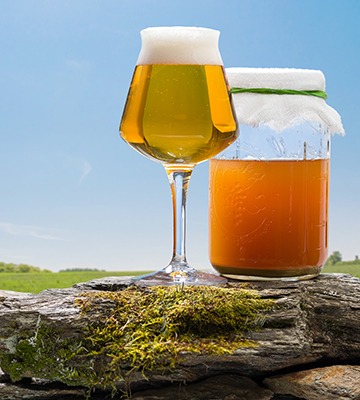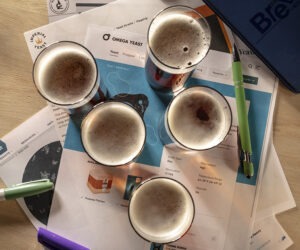Novel Yeasts
And where to find them

To say the least, it’s been an interesting period of experimentation in the brewing world the last decade or so. Most brewers have been awed by the evolution of hops in that time, but nothing is changing quite as rapidly as the microorganisms that we are inoculating in our wort and beer. Our choice of Lacto and Brett has grown a lot as well as brewer’s yeast strains through lab techniques like genetic modification and hybrids. Lesser-known organisms like Lachancea are being developed for brewers as well. And yet I will argue that there is still a lot more diversity out there to explore for those willing to search.
For thousands of years, beer and all the fermented foods collectively have played a vital role in the development of human civilization. During this time, Saccharomyces cerevisiae co-evolved with human activity in many civilizations throughout the world, becoming the workhorse for the production of alcoholic beverages. The switch between artisanal scale to a more industrial brewing regime with all its process optimizations was triggered by the discovery made by the French scientist Louis Pasteur, who demonstrated that the transformation of malt sugar into ethanol (alcohol) and CO2 was due to the activity of a microorganism.
That was followed by Emil Christian Hansen who, in 1883, brewed the first single yeast isolate beer. Thenceforth, spontaneous fermentations and their complex microbiomes were replaced by S. cerevisiae for “ales” and S. pastorianus for “lagers,” for their more reliable and reproducible products, resulting nowadays in only a few strains used in beer production that have low genetic diversity among themselves. However, with the recent emergence of craft brewing and the increasing demand for novel beer styles, diversification is becoming increasingly important. Yeast has room for bringing innovation due to its significant contribution in shaping beer’s aroma profile.
Bioprospecting for Brewers
Numerous studies have been done on the S. cerevisiae yeasts directly related to human-based activities, such as making bread and fermenting wine or sake. But only a small number of yeasts from these sources have shown promise in beer. Only other historically established old-style beers, like the traditional Norwegian kveik beer and the Finnish sahti beer, which both use juniper in place of or in addition to hops, or the Russian kvass, made with bread, have so far provided encouraging strains.
Broadening the perspective, one might also concentrate emphasis on less conventional fermentations, where native yeasts may have evaded some of the domestication processes and hence give a larger natural variety. Another idea is to look on other natural substrates/raw materials besides grains and grapes, such as the honey-based mead, in order to avoid selecting again and again yeasts that are comparable to what is presently in use.
Other fermented foods could also serve as a target for novel yeast isolations, such as fermented dairy, coffee, or cocoa beans
There are still a lot of traditional drinks to discover, such as classic low-alcohol European drinks or fermented drinks made by Australian Aboriginal people (Mangaitch, Way-a-linah, and Kambuda). Around 3,500 different fermented foods and beverages were listed by G. Campbell-Platt’s 1987 book Fermented Foods of the World, but there may be more than 5,000 different variations of these products consumed globally now.
The capability of yeasts from fermentations such as those that produce chicas, cachaça spirits, pulque, tequila, or sub-Saharan alcoholic beverages, to produce beer has not yet come to light. Other fermented foods could also serve as a target for novel yeast isolations, such as fermented dairy, coffee, or cocoa beans. In addition, industrial bioethanol production has been reported to be a rich source of S. cerevisiae strains, showing they harbor a potential for use in the brewing industry.
Methods for Isolating Yeasts From the Wild
Until recently, we had the wrong idea of the origin and evolution of S. cerevisiae: Because of its metabolism, it was initially thought that S. cerevisiae would mainly reside on the surface of fruits. But the truth is that its presence there is rather scarce. It was shown that yeast cells are most likely transferred to vineyards or orchards via insect vectors that feed off damaged fruits. The most common uncultivated habitat from which Saccharomyces species have been isolated is instead fluxes of oaks and other broad-leaved trees. And the most primitive S. cerevisiae populations to date were actually isolated from remote ancient forests in China.
There are two main challenges when it comes to isolating wild S. cerevisiae strains from these habitats: Choosing the right spot during sampling and avoiding isolating strains of the “common” genotypes. Following is a recipe originally proposed by Sniegowski et al. (2002) that allowed for the isolation of dozens of S. cerevisiae and Saccharomyces paradoxus strains from soil samples around oaks and the famous unknown parent of Saccharomyces pastorianus, the cryotolerant yeast S. eubayanus.
How to prepare 1 L of enrichment culture media for isolating yeast:
- 3 g yeast extract
- 3 g malt extract
- 5 g peptone
- 10 g sucrose
- 76 mL EtOH (ethanol)
- 1 mg chloramphenicol
- 1 mL of 1-M HCl (hydrochloric acid)
Instructions:
Stir the two extracts, peptone, and sucrose together in 1 L of water. Heat to a boil or in an Instant Pot for 5–15 minutes. After cooling, add the ethanol, chloramphenicol, and 1 molar hydrochloric acid. Sterilized 50 mL vials are good sized vessels to view activity. In as sterile a setting as possible, pour solution into vials, filling about halfway.
Temperate climate broad-leafed forests are probably going to be the best place to look, preferably around a stand of oak trees. Using a sterile scalpel or spatula, scrape some exudate material, bark, and soil samples from around the base of the trees into each vial. Cap your vials tightly, then incubate for approximately 10 days at 86 °F (30 °C) without shaking. Inspect regularly for signs of fermentative CO2 production.
New Challenges and Perspectives
As conventional brewing yeasts have been evolving through processes of natural and artificial selection, they developed a high fermentation efficiency and quality, but at the cost of having limited potential for novel flavor profiles. To produce unconventional beers the brewers have to consider the properties of unconventional yeast coming from a natural and non-brewing environment. Common features of these new yeast isolates could create some issues: Poor flocculation, low attenuation, and high volatile phenol production can be addressed with a centrifuge, beer clarification additives, or changing mashing conditions to optimize the proportion of fermentable sugar or the level of ferulic acid (the precursor of the 4-vinylguaiacol off-flavor). With an innovative mindset and laboratory-based screenings, it’s possible to go in pursuit of wild or nonconventional yeast strains possessing brewing-relevant characteristics.
The adaptability of yeasts is also evident in their genomics and as the number of published yeast genome sequences rapidly increases, another opportunity also arises for identifying in silico unique strains suitable for brewing. By looking at 1,011 S. cerevisiae strains described by Peter et al. (2018), available at https://www.yeastgenome.org/reference/S000216438, it is possible to rapidly screen thousands of strains. For brewing applications, this could involve looking for the presence of genes encoding functional maltose and maltotriose transporters or mutations in genes associated with the synthesis of aroma compounds.
References
• Gallone, B., Steensels, J., Prahl, T., Soriaga, L., Saels, V., Herrera-Malaver, B., et al. (2016). Domestication and divergence of Saccharomyces cerevisiae beer yeasts. Cell 166, 1397.e16–1410.e16. doi: 10.1016/j.cell.2016.08.020
• Campbell-Platt, Geoffrey. Fermented foods of the world. A dictionary and guide. Butterworths, 1987.
• Sniegowski, Paul D., Peter G. Dombrowski, and Ethan Fingerman. “Saccharomyces cerevisiae and Saccharomyces paradoxus coexist in a natural woodland site in North America and display different levels of reproductive isolation from European conspecifics.” FEMS yeast research 1.4 (2002): 299-306.
• Christiaens, Joaquin F., et al. “The fungal aroma gene ATF1 promotes dispersal of yeast cells through insect vectors.” Cell reports 9.2 (2014): 425-432.
• Peter, Jackson, et al. “Genome evolution across 1,011 Saccharomyces cerevisiae isolates.” Nature 556.7701 (2018): 339-344.



